Archive for March 2014
MPs, lords to face anger over failing UK broadband roll-out
Parliamentarians will meet tomorrow to discuss broadband policy amid growing anger and concern among businesses that almost £2bn in taxpayers’ subsidy will leave the UK in a worsening competitive position.
Digital Policy Alliance chairman Lord Erroll will chair the meeting (see below for details) that will hear from two recent papers that show that large parts of the UK will end up with broadband access one-fortieth of that of South Korea, and far behind France, Brazil and China by 2017, the deadline for the government’s current broadband spending plans.
The report from Digital Business First (DBF) flatly contradicts Ofcom’s recent finding that the UK leads Europe in high speed broadband. In an open letter to Ofcom CEO Ed Richardson, the DBF said, “When ranked against all 27 EU states (not just the five Ofcom conveniently chose for the sake of a headline) the UK ranks tenth, behind countries like Portugal, Denmark, Belgium, Lithuania and Latvia.
“Secondly, there are large areas of the UK (approximately 10 million homes and businesses according to the government’s own figures) that are to be supported with public funding to deliver ‘target’ broadband speeds of just 2Mbps and 24Mbps (via the BT network). These speeds are well below even Ofcom’s low threshold of ‘superfast’ broadband. These ‘have nots’, which include some of our most productive business premises in rural locations, are being left to languish in the slow connectivity lane indefinitely.”
The forum’s assertions are supported by a study of the effect of line lengths on broadband speeds by researchers at Edinburgh University. The researchers found that one in eight Scottish homes is unlikely to be able to get more than 24Mbps, and 40% of rural homes and businesses will struggle to get more than 2Mbps.
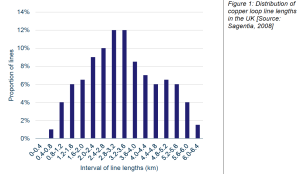
The average line length of Openreach’s network is around 3.4km. The average length from street cabinet to a premises is around 420m. This is enough for 40Mbps download speed provided BT implements vectoring on its VDSL lines. Not every line in every cabinet is being so enabled in its next generation roll-out, and at least 10% of cabinets are unlikely to be enabled.
Openreach, BT’s network infrastructure division, redacts its line length information in recent public documents. However, in a 2011 report on line lengths and line costs to Ofcom, Analysys Mason said that BT had confirmed (in 2004) that its average line length (between the exchange and the premises) was 3.47km (including the dropwire length). “This provides a reasonably good reconciliation with the (2008) Sagentia analysis (3.34km average line length). The same presentation also confirmed the distribution of lengths between the cabinet and the customer, with a typical 420m length and a small proportion of lines (10%) with a very long length,” it said. Analysys Mason later calculated the average Openreach line length at 1.704km – a figure hotly disputed by Openreach.
A 2011 White Paper by Alcatel-Lucent on the use of vector technology with VDSL2, the technology chosen by BT for its next generation broadband roll-out, found that at 420m, the average download speed would be about 40Mbps, while at 1.2km, it would drop to about 24Mbps (see graph).
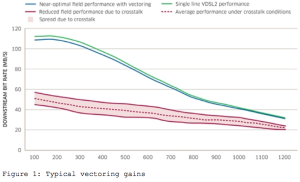
How broadband peters out. Source: Alcatel-Lucent http://bit.ly/OO9Ovy
Figures from the Office of National Statistics show a declining trend in the construction of communications infrastructure (see graph). The ONS figures include post office buildings and sorting offices, but also exchanges and cables. This suggests that few new cables have been laid in the past 15 years, so Sagentia’s figures are likely to be reasonably accurate.
(Unfortunately, the ONS bundles sales figures for telecommunications equipment with those of computers. This makes it impossible to establish accurately what UK network operators have invested in network hardware and software.)
As noted earlier, Openreach’s capex has been steady at around £1bn for several years. But it is starting to decline as it comes to the end of its “commercial” broadband roll-out to cover two-thirds of the population, but only one-third of physical UK.
In BT’s case, Alcatel-Lucent appears to have made a convincing argument to go for vectoring over VDSL2. It said, “Reusing existing infrastructure reduces investment costs and risks. It also helps with eco-sustainability targets. With VDSL2 Vectoring, you can deliver higher speeds at about 1/3 the cost of deploying fibre. And any fibre investments to support VDSL2 Vectoring lower costs for future fibre deployments.”
But as its own figures show, this is true only where line lengths are short, and it does not appear to include any offset for reclaiming the copper and reusing the ducts.
DBF members Alex Pratt and Frank Nigrello, who represent local enterprise partnerships in Buckinghamshire and Oxfordshire respectively, accuse Ofcom of painting an “unduly rosy picture” that serves the UK badly. “It amounts to institutional denial of the need for a significant change in policy towards investment in digital infrastructure. It is leading to an unnecessary rapid regional and national decline in our relative productivity and competitiveness. It is akin to adding extra weight to handicap our businesses in what the prime minister has called ‘The Global Economic Race’.”
The DBF is highly critical of what it sees as the government’s casual approach to broadband. “Current government policy and funding has failed to bridge the superfast broadband infrastructure deficit for 35% of the UK,” it says. It attributes this to a lack of consultation with user communities; adopting the “least ambitious targets and technological means” to deliver them, and to a lack genuine incentives for investment in future-proof high speed broadband networks.
Quoting from the National Audit Office report on the rural broadband roll-out, the DBF said, “The department (of culture media and sport said) its aim was to achieve the most possible with the given funding, not to lever the maximum amount of private investment.”
It added, “The current argument between Ofcom and mobile networks on spectrum fees, with the latter threatening to reduce 4G coverage unless fees are lowered, points to a far less investment friendly approach in the UK.”
The DBF report also criticises the lack of ambition in making high speed broadband a universal service. Again quoting the NAO report it said, “The effect of designing a programme which only reaches 90% of the target area will make it more expensive at a later stage to cover the final 10%. It will also make it less commercially viable for anyone other than BT to bid, as no-one else will have existing infrastructure to bolt it on to.
“Matters are made worse by the fact that BT is preventing local authorities from publishing plans showing which areas will not be covered, which would enable other, often community-based consumers, from filling the gap and ensuring 100% coverage.
“Witnesses from the broadband industry told us that potential investment by competitors had been lost. For example, UK Broadband has spent none of the £150m it had allocated for the programme. Fujitsu had also stated an intention to invest £1.5bn which has not been invested. In total, INCA estimated that the investment that had been foregone was at least £2.7bn.”
The DBF calls for a national broadband plan and responsibility for its delivery to be moved the department responsible for business and enterprise.
“Any incoming government in 2015 should be specifying a target of at least 100Mbps for the UK ‘have nots’ within two years,” it says.
It called for the UK to re-establish its world lead in mobile communications by “adopting an ambitious ‘can do’ approach to 5G technology”. 5G networks offer the prospect of universal ultrafast (1Gbps) broadband across the UK, it said.
It also called for changes to the terms of the 4G mobile licences to ensure that the coverage obligations include a signal strong enough to deliver 10Mbps inside a home for 98% of the UK population, a voice service, and for more than one 4G mobile network to have the above coverage obligation.
The meeting takes place on 24 March at 15.10-17.00 in Committee Room 4A, House of Lords, Westminster.
The agenda is:
* Welcome and introduction by Lord Erroll, DPA chairman
* Presentation of European Internet Foundation’s (EIF) report ‘The Digital World in 2030: What Place for Europe?’ by Peter Linton, advisor to EIF board of governors and co-author of the report
* Presentation of Digital Business First’s report “The UK’s enduring broadband deficit: A divided nation – Time for an effective plan” by Alex Pratt, chairman Buckinghamshire Business First and Buckinghamshire Local Enterprise Partnership (LEP).
* Comments by Stephen McGibbon, EMEA regional technical officer, Microsoft; Peter Olson, president of Digitaleurope and head of European Affairs, Ericsson; Alexandra Birtles, head of external communications, TalkTalk Group; and parliamentary contributions with closing remarks by James Elles, MEP and EIF co-founder.
Show us the money, PAC’s Hodge warns contractors
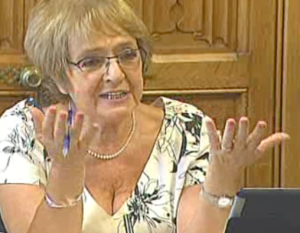
PAC chairman Hodge – ‘There is a lack of transparency and openness around government’s contracts with private providers’.
A government report into private contractors who deliver public services has suggested the government is to blame for the lack of transparency that has led to serious shortcomings in value for money for taxpayers.
“These failures have exposed serious weaknesses in the government’s ability to negotiate and manage contracts with private companies on our behalf,” public accounts committee chairman Margaret Hodge said at the release of the PAC’s report on private contractors and public spending. The report may have implications for contracts worth £1.4bn BT has signed with county councils to deliver next generation broadband.
The PAC report looked at contracts with G4S, Atos, Serco and Capita. Some, such as the G4S and Serco contracts to tag prisoners electronically, and G4S to supply security to the 2012 Olympics, have become notorious for their abuse of the spirit of partnership, in particular for over-charging.
“There is a lack of transparency and openness around government’s contracts with private providers, with ‘commercial confidentiality’ frequently invoked as an excuse to withhold information,” Hodge said.
The PAC earlier identified these traits in the BT contracts, all of which are subject to non-disclosure clauses and restrictions on speed and coverage details and financial information.
“These failures have also exposed serious weaknesses in the government’s ability to negotiate and manage contracts with private companies on our behalf,” Hodge said.
“It is vital that parliament and the public are able to follow the taxpayers’ pound to ensure value for money. So, today we are calling for three basic transparency measures:
- the extension of Freedom of Information to public contracts with private providers;
- access rights for the National Audit Office; and
- a requirement for contractors to open their books up to scrutiny by officials
“The four private contractors we met – G4S, Atos, Serco and Capita – all told us they were prepared to accept these measures. It therefore appears that the main barriers to greater transparency lie within government itself.”
Hodge said an absence of real competition had led to privately-owned public monopolies that had become “too big to fail”.
Small and medium enterprises (SMEs) had been crowded out by the complexity of the contracting process, excessive bureaucracy and high bidding costs.
Contracting had led to the evolution of privately-owned public monopolies, who largely, or in some cases wholly, relied on taxpayers’ money for their income. “The state is then constrained in finding alternatives where a big private company fails,” she said.
“We intend to return to this issue. Government is clearly failing to manage performance across the board, and to achieve the best for citizens out of the contracts into which they have entered. Government needs a far more professional and skilled approach to managing contracts and contractors, and contractors need to demonstrate the high standards of ethics expected in the conduct of public business, and be more transparent about their performance and costs,” Hodge said.
“With the government choosing to contract out more and more public services to the private sector, these issues become ever more important. This report is intended as a recipe for better services, better governance and greater openness. We hope the government will take heed of our recommendations.”
What does BT’s bikini broadband budget reveal?
It’s always interesting to play with numbers, and few are as interesting to this blog’s readership as BT’s. As someone once said of bikinis, the figures they reveal are interesting; what they conceal is vital.
Of special interest at present is BT’s capital spending plans. As we can see from the graph, which is compiled from BT’s annual reports and analysts’ estimates, BT spends around £2.5bn a year on capital goods. Of this, Openreach is responsible for around £1bn a year, so we can assume that’s what BT spends on its network infrastructure.
To put that into perspective, Vodafone plans to spend £900m this year to bring its network up to speed with 4G/LTE technology and 98% national indoor coverage. Mobile rival EE spent £606m in 2012 and another £583m in 2013.
Back to BT. On page 76 of a presentation to shareholders in May last year, which accompanied BT’s 2013 annual report, BT sketched the scenario shown at right.
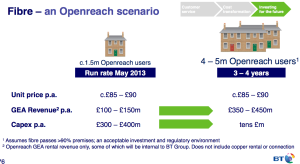
Openreach believes superfast broadband take-up will reach at least 15% in 3-4 years. It’s already 11%.
This suggests that of the billion quid a year that Openreach spends, some £300m to £400m will go on General Ethernet Access, which we all know as Next Generation Broadband. Keep that up for four years and BT will have invested some £1.4bn getting its fibre network to “pass” more than 90% of the population. After that, its ongoing GEA capex drops to “tens of millions” a year, but its revenue rises to £350m to £400m a year. Which looks like a nice little earner for BT from Year 4 on.
That’s very interesting, especially to shareholders and the government, which has at least two different reasons to be interested – the resulting contribution BT could make to BT pension deficit, and the £1.4 billion it is giving BT to roll out next generation broadband in those areas that BT deems uneconomic.
Hang on a sec. BT says it will invest £1.4bn to cover more than 90% of the population, and the government is giving BT £1.4bn to cover the one-third of the population that BT claims it can’t afford to cover. Now that’s really interesting. It rather looks as if BT has managed to redefine matched funding as meaning it has matched the government’s supply of money with its demand for money. Alternatively, that taxpayers are paying for BT’s commercial roll-out as well the Final third.
And, lest we forget, what happened to the £2.5bn former CEO now trade minister Ian Livingston was keen to say BT was spending on its next generation broadband upgrade? Where’s that now? Did he mean BT’s commercial upgrade or the total upgrade?
This might offer a clue. BT has around 55,000 street cabinets to upgrade. If we assume that 50% of the £1.4bn is overhead, contingency and profit, that works out to capex of £12,727 per cabinet and its associated fibre “path”.
Which is not a million miles from the £12,667 Iwade paid for its single cabinet and path, nor the £13,000 average it cost Northern Ireland in its BT-run NGA roll-out.
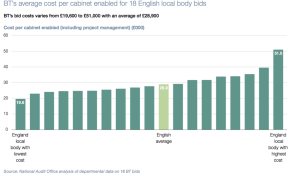
Iwade’s cabinet cost £13k. Lucky them.s single cabinet and path, nor the £13,000 average it cost Northern Ireland in its BT-run NGA roll-out.
The vital information that is still hidden are the numbers that persuaded the National Audit Office that BT has to spend an average of £28,900 per cabinet and path in England’s Final Third, likely to be the cheapest
Nevertheless, one can now start to see how BDUK can claim to be able to cut 30% out of BT’s invoices for non-hardware items in the few framework invoices it has seen.
Lies, damn lies, and broadband statistics
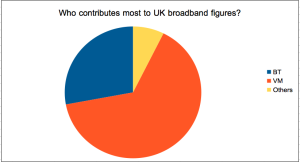
VM’s contribution to the UK’s high speed broadband figures is twice that of BT. Source: Company quarterly reports
Ofcom has released a report suggesting that the UK is leading its peers in the race to become a superfast broadband nation.
For various reasons it chose to measure the UK against France, Germany, Spain and Italy, rather than the EU28, the Nordics or the members of the Commonwealth of Independent States, formerly known as the Soviet Union.
Ofcom found the UK has the highest broadband take-up (all types, by household), at 83%; the highest proportion of people to have bought goods online over a year (77%); the highest weekly usage of the internet (87%); and the lowest proportion of people who have never used the internet (8%).
Ofcom’s own figures for fixed connections, quoted in the report, give a more optimistic view: “France (is) still leading the EU5 with 36 connections per 100 people, followed by Germany (35 connections per 100 people), the UK (34), Spain (24) and Italy (22).”
Ofcom went on to say, “Eurostat data suggests that 83% of UK households had fixed broadband access at that time, the highest reported rate of household penetration among the EU5. Our own research suggests that 75% of UK households had fixed access broadband connections in October-December 2013.
“Take-up of superfast broadband, which is capable of providing speeds equal to or greater than 30Mbps, had reached nine in every 100 people in the UK at the start of last year, the highest in the EU5 ahead of Spain (6 in 100) in second place.”
When questioned on this, Ofcom responded, “We’re slightly mixing data here. 83% refers to households and comes from Eurostat (Q1 2013); the 9% superfast up figure is for individuals and comes from Cocom (Jan 2013). So we can’t combine the two.”
We also asked how many households could access broadband at more than 30Mbps, and how many received less than 2Mbps in Market 1 and Marlket 2 areas, ie those where BT has little or no competition. Ofcom can’t tell us because it doesn’t have the data.
Ofcom responded, “In order to get the picture across speeds, I’d suggest our Infrastructure Report Update 2013, which has this:
Broadband take-up: 72% of households (Q1 2013 – p.19)
>30Mbit/s take-up: 16% of premises (households and small businesses) have superfast connections/22% of BB connections are superfast (June 2013 – p.27)
<2Mbit/s take-up: 8% of connections (p.21)”
The Office for National Statistics (ONS) says there were 26.4 million households in the UK in 2013. Of these, 29% consisted of only one person and 20% consisted of four or more people.
BT, in its quarterly report to 31 December, said it had “now passed more than 18m premises in the UK with our fibre broadband network and (is) making progress with extending the reach of fibre to rural areas.”
As that covers 68% of UK homes, that suggests that BT has completed its roll-out to “two-thirds” of commercially viable UK homes.
BT went on to say “Openreach achieved 339,000 net fibre connections, an increase of 38%, with around 2.4m homes and businesses now connected. We added 228,000 retail fibre broadband customers, up 14%, and now have around 1.9m customers.”
Regrettably, BT doesn’t say what speeds its customers get. Regular readers will know that BT’s “up to 80Mbps” service, based on fibre to the cabinet GPON/VDSL technology, is a bit of a pig in a poke. Actual speeds depend on distance between the cabinet and the premises, line condition, network congestion, content filtering, traffic shaping and other factors that degrade the service people pay for.
Other things being equal, line length is the main factor that affects broadband speed. Openreach keeps secret the average line length, but it is longer than 1km. Analysys Mason has calculated it at 1.704km. According to ThinkBroadband, that should deliver a download speed of under 15Mbps; for 30Mbps you need to live within 750m of the cabinet. BT speakers have earlier claimed the average length of the line between premises and cabinets is around 900m. According to ThinkBroadband, this would give a download spped of about 24Mbps.
Virgin Media also operates a fibre to the cabinet (FTTC) service based on DOCSIS 3.0 technology using coaxial TV cable rather than twisted copper pair wires between the cabinet and the home. Its latest quarterly report reveals that “Of all of our 4.4 million internet customers, 3.2 million, or 74%, subscribe to superfast broadband services of 30 Mbps or faster, an increase of 1.0 million in twelve months, including a 209,300 increase in Q4. We continue to see that nearly half of our new internet customers subscribe to speeds of 60 Mbps or higher, showing the strong, ongoing demand for faster speeds.”
Now we are in a position to judge whether Ofcom’s claims to be leading Europe are worth anything, even if true in the limited context it chooses.
Adding BT’s 1.9 million and VM’s 4.4 million gives us 6.3 million customers. BT said Openreach had connected 2.4 million premises, so we should add 500,000 LLU lines, giving a total of 6.8 million customers connected to a fibre-enabled cabinet. That is a fixed line penetration rate of 26%. However, if we consider that, according to Analysys Mason’s figures, less than half of those on Openreach lines will receive a service of 30Mbps or faster, the household penetration rate drops to around 17%.
If the Ofcom report is measuring progress towards the EU’s 2020 target of 30Mbps for all with 50% using a 100Mbps service, as it seems to be, then we are a long way short of achieving the EU targets, or even Ed Vaizey’s nebulous “best broadband in Europe”.
Fibre tax no longer fit for purpose?
The current system of business rates is not fit for purpose and needs to be fundamentally reformed, say MPs.
The call could open the way for a reassessment of the so-called fibre tax that makes BT’s competitors pay 20 times more to operate fibre networks. It could also kill efforts by civil servants to tax Wi-Fi hot-spots, which areincreasingly important to backhaul data on mobile broadband networks.
A spokesman for the business, innovation and skills committee said that while its study focused purely on the effect of the tax on the retail sector, it was possible a full review would examine the effect and desirability of the fibre tax.
Normal network operators must pay the tax whether or not they make a profit and in advance of sales. However BT pays the tax in arrears and on profits, while Virgin Media pays based on the number of homes passed by its network.
The committee called for a “wholesale review” to examine whether non-domestic property taxes aka business rates should be based on sales rather than the rateable value of a property and how frequently revaluations should take place, among other things.
The call for the review was prompted by the growing success of e-commerce and consequent slackening in demand for high street premises as a sales channel.
Chairman Adrian Bailey said business rates are one of the highest forms of local property tax in the European Union, adding, “Business rates are the single biggest threat to the survival of retail businesses on the high street. Since the system was created (in the 1600s) the retail environment has changed beyond all recognition. A system of business taxation based on physical property is simply no longer appropriate in an increasingly online retail world.
“This is a time for wholesale review and fundamental reform, not for tinkering around the edges. Business rates are not fit for purpose and minor administrative changes will not alter that.
“The government’s retail strategies are full of warm words that fail to address the most debilitating levy on existing businesses and the most crucial deterrent to new businesses appearing on the high street – business rates. Fewer strategies are required; simple, decisive action is needed.”
The government must respond by 4 May.
Real fibre broadband comes to 500 Northmoor homes
In a rare bit of good news for the altnet community, Gigaclear announced it has won funding from the Rural Community Broadband Fund (RCBF) to design, build, implement, and operate a fibre to the premises (FTTP) broadband network to serve around 500 homes in Northmoor, Oxfordshire.
Just weeks ago Gigaclear scrapped a planned rollout in Dun Valley, Wiltshire after it discovered BT planned to use taxpayers’ money to provide a fibre to the cabinet (FTTC) service to the area.
Gigaclear won the contract in an open procurement by West Oxfordshire District Council (WODC) after the parish secured an RCBF grant from the Department for the EnvironmentFood and Rural Affairs (DEFRA). The value was not disclosed.
In a survey of residents’ needs, 14% of respondents said they could get no broadband service at all. A quarter of responses were either from business premises or from residential premises used by people to work from home and/or run their own businesses. Better broadband was high on their priority list.
Graham Shelton, chairman of the parish council and leader of the broadband group, said talks with Oxfordshire County Council revealed the parish would be likely to fall outside the area covered by Oxfordshire’s £4m Broadband Delivery UK (BDUK) subsidy. “That freed us to pursue other options. We were aware of Gigaclear’s work elsewhere, so were delighted they won on merit.
“The network will ensure that everyone can obtain equally superfast broadband and that it will be available to all properties in the parish – including a number of caravans.”
Gigaclear is expected to finish the network in September.
Scotland’s broadband plan leaves 356,000 out in the cold
UPDATE
One in eight Scottish homes is unlikely to get a broadband service greater than 24Mbps, but up to 40% of rural homes will be left behind, following million of pounds of taxpayers’ money given to BT, say researchers at Edinburgh University.
Michael Fourman and Peter Buneman, professors at at the School for Informatics, say the current claim that the £410m investment to get 95% of premises in Scotland on to superfast broadband by the end of 2017-18 “is not credible”.
“According to our calculations, less than 85% of Scottish households will have access to superfast broadband, and the long-term prospects for rural Scotland are dismal. We predict that at least 43% of the 450,000 households in rural Scotland will not receive superfast broadband from the current programme.”
Fourman and Buneman have revised their estimates downward after they discovered a bug in the program they used to calculate the expected shortfall, and in response to feedback over the correct distance over which to calculate VDSL performance. Fourman has sent an exhaustive reply complete with tables.
He says:
There are many approximations to be chosen and caveats to be stated. We can produce many different sets of estimates, but that fact should not obscure the underlying issues:
Unless there is substantial investment in hundreds new fibre-fed cabinets (or equivalents), (or in FTTH where there are exchange only or too-long lines 🙂 :
1. In rural areas at least 40% of households will not get superfast (>24Mbps) unless we shorten some copper beyond existing exchanges. If we focus on remote rural areas, that number rises to 45% and in very remote rural areas to over 60%.
These are optimistic estimates based on theoretical performance of good copper. Using empirically-based estimates for copper speeds gives higher stillslow figures: 49% for rural overall; 52% for remote rural; and 71% for very remote rural.
2. Even in urban areas it is unlikely that 95% will get superfast (>24Mbps) speeds. If we use empirically-based estimates for copper speeds then one in eight households in urban areas of Scotland are unlikely to be able to achieve the EU target of 30Mbps.
Now please fill in the poll below so that we can get some reliable numbers.



